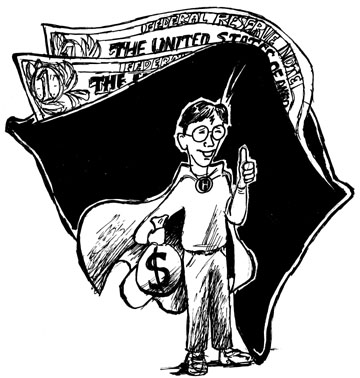KID$!
Real story is Harry Potter and the Big Fat Wallets of Preteens
By Alex De Grand
And, oh how they danced, the little children of Stonehenge! Beneath the haunted moon! For fear that daybreak may come too soon!
- Spinal Tap

Celebrations in the last hour of July 7 at a local bookstore were ostensibly held to mark the final moments of a world deprived of Harry Potter and the Goblet of Fire, the fourth installment of the children's story about a boy attending a sorcerer boarding school.
But in truth, the party was for the children themselves. And why not? These little consumers have got big bucks to spend - it's their tidal wave of support floating Harry Potter to the top of the bestseller list.
Cake and activities were arranged to entertain these hordes of 21st century children dressed in bizarre homage to the commercialized aspects of the 13th century - a confused historical blending as if Charlemagne were having his twelfth birthday at Burger King with those lame paper crowns.
Humorist Mary Jo Pehl once said of another alarming stab at entertainment: "It's a delightful Bambi romp through a flowery fairy land of happy, harmless, fru-fru family fun for the whole family of all ages... or is it?"
Such thoughts can flit through one's head while observing this blowout.
Kids puttered about the store with the lightning insignia on their foreheads, as worn by Harry Potter. For many, however, the effect appeared to be a poorly applied Ash Wednesday smudge at the hands of an arthritic priest.
An exceptionally well-fed child with cake smeared around his punch-stained mouth wore a T-shirt proclaiming himself a member of some sporting team at the fictional boarding school featured in the books. Indeed, only in a fantasy world would this carb-loading kid be an athlete.
Like Romper Room for dopey druids, children were led through a build-your-own-magic-wand exercise with rolled-up newspaper, tin foil, stickers and some ribbons. Alas, build-your-own-20-sided-die activities wait for another day.
Some parents sat in with their children for the activities. Others took enough pictures to send Kodak stock soaring a thousand points. A few appeared profoundly bored.
The store presented for the children's amusement a series of adults dressed up as characters from the books including Harry Potter himself, although to the discerning eye, this Potter looked more like Buddy Holly on a three-day bender than the charming moppet on the book covers.
One kid expressed doubt over the authenticity of this Potter stand-in, but a woman urged the child to believe.
"If you don't believe in Harry Potter, why read the books, right?" the woman said, a statement that raises interesting ontological issues over pretty much everything. If one reads letters to Penthouse Forum, does that act transform those bogus sexual episodes into cold, hard reality?
Why lavish this kind of attention on these little folks as though they were a conquering, consuming force?
Probably because that is exactly what they are. American Demographics magazine identifies the kids' market as one evolving into an army with about $35 billion of its own money to blow and access to $300 billion of their parents' cash.
The Census Bureau estimates slightly fewer kids as a percentage of the American population today than at the start of the 1990s, but that hasn't stopped their economic power as a group from reaching historic highs.
American Demographics figures children's aggregate spending doubled during each decade of the 1960s, 1970s and 1980s. But those rates roughly tripled in the 1990s.
In 1991, a typical 10-year-old kid got $4.20 a week for an allowance, the magazine notes. In 1997, that figure grew to $6.13.
Simultaneously, kids have seen the size of other income - like gifts from grandparents and odd jobs such as baby-sitting - increase.
From 1991 to 1997, the magazine reports, the average 10-year-old's weekly income has risen 76 percent from $7.90 to $13.93.
Potter author J.K. Rowling would be reduced to peddling her tales of a prepubescent sorcerer trainee at sad little Renaissance Fairs without such a surfeit of kids who are willing and able to pony up $25.95 for the latest installment.
With the children on her side, Rowling is kicking the publishing world's ass.
Behold the spending power of the modern preteens and their lusty consumer appetite that would make a medieval king belch with delight!
Newsweek reports the first run of the latest Potter book clocks in at 3.8 million copies in the United States alone and the pre-release orders as of July 1 for the new Potter book made it Amazon.com's number one best seller for 16 of 21 weeks.
Keeping those kinds of numbers in mind, it makes sense for bookstores to throw a party for their best customers. Even if those customers can barely reach the counter top to hand over a moist, gummi bear-flavored fistful of dollar bills.